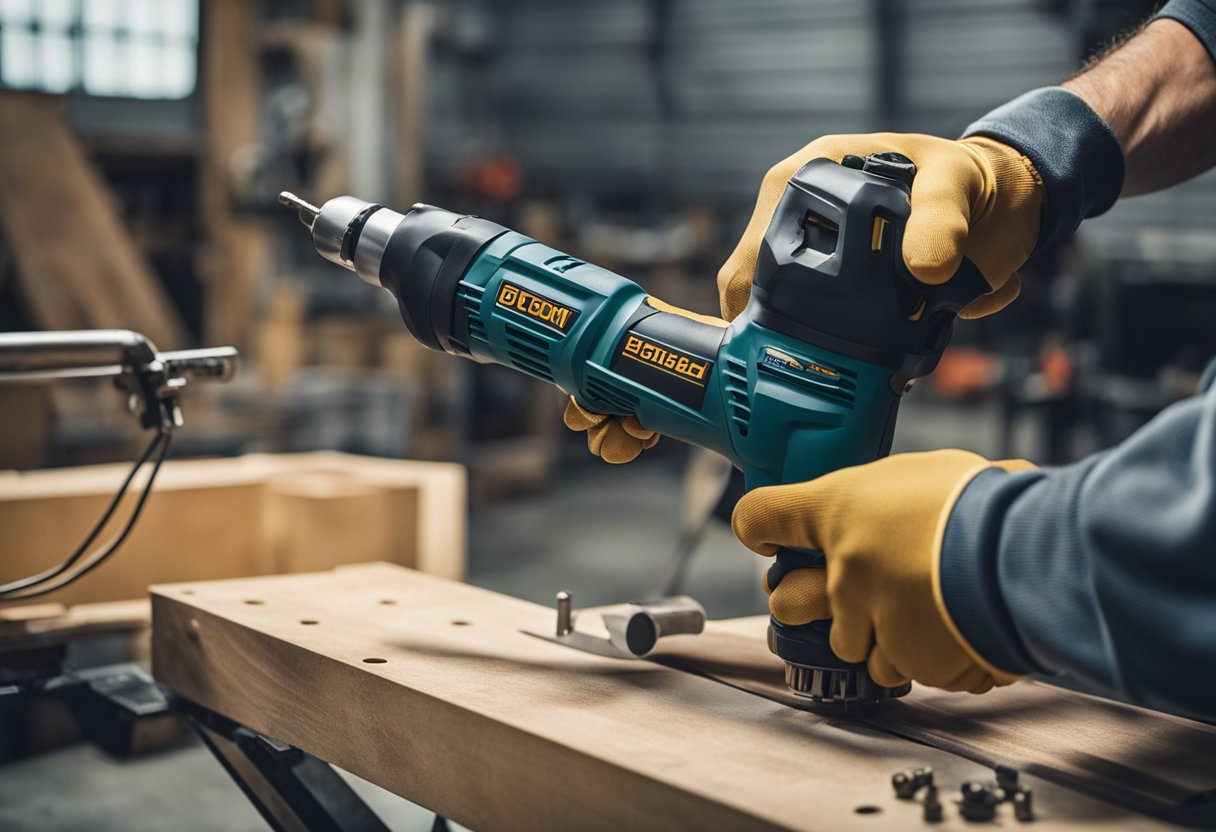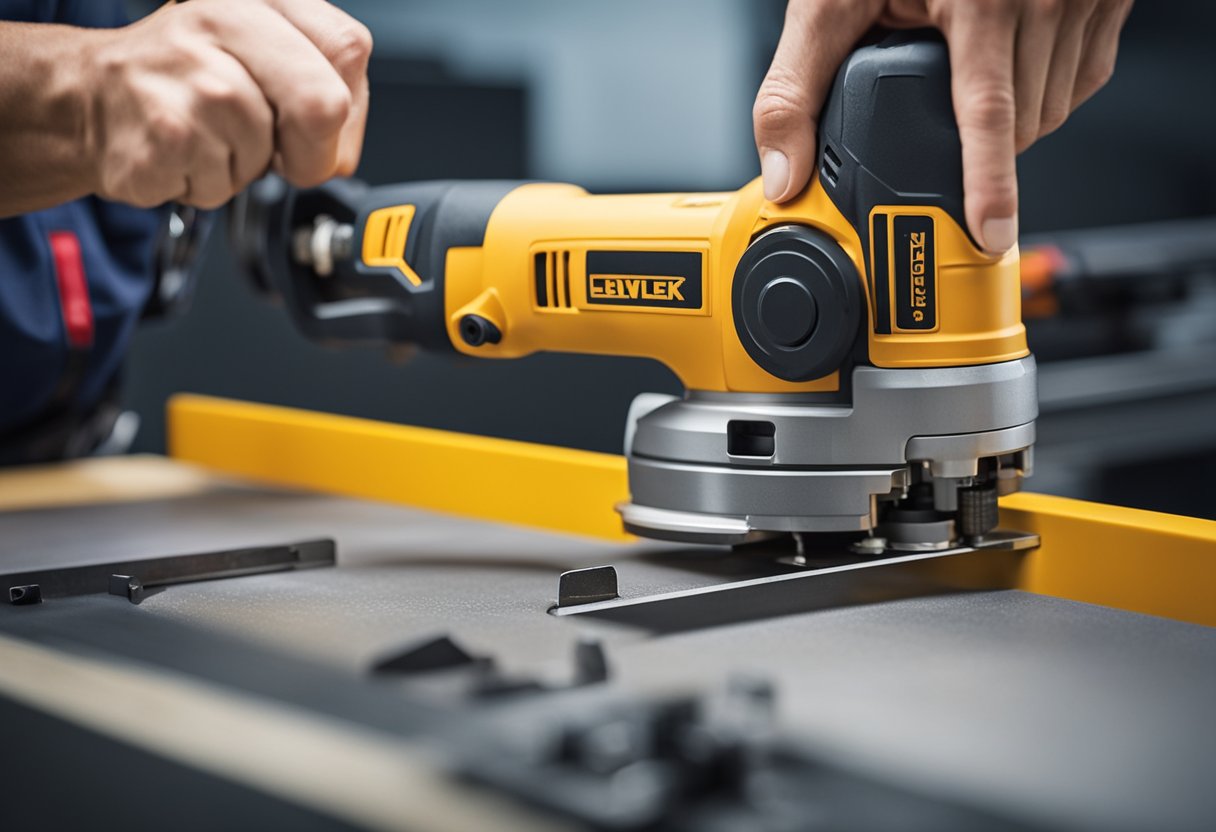Changing an oscillating tool blade might seem like a daunting task, but it’s actually quite simple once you know the right steps. Whether you’re a DIY enthusiast or a professional contractor, knowing how to change an oscillating tool blade is a crucial skill to have. With the right tools and techniques, you can easily swap out blades on your oscillating tool and get back to work in no time.

Before we dive into the blade changing process, it’s important to understand the different types of blades available for oscillating tools. There are a variety of blades available for different applications, including cutting, sanding, and scraping. It’s important to choose the right blade for your project to ensure the best results. Once you have the right blade, you’re ready to change it out using the proper techniques.
Key Takeaways
- Understanding the different types of oscillating tool blades is crucial for choosing the right blade for your project.
- Safety precautions should always be taken when changing an oscillating tool blade.
- Following the proper blade changing process will ensure a quick and easy swap.
Understanding Oscillating Tool Blades

As an oscillating tool user, it is essential to understand the different types of blades available in the market. The blades come in various shapes, sizes, and lengths, each designed to perform specific tasks.
When it comes to selecting the right blade, you have to consider the material you will be cutting and the type of cut you want to make. For instance, if you want to make a plunge cut, you will need a blade with a pointed tip. On the other hand, if you want to make a flush cut, you will need a blade with a straight edge.
It is also crucial to keep an eye on the blade’s condition to ensure optimal performance. A dull or damaged blade can cause the tool to overheat or produce poor results. Therefore, it is essential to replace the blade when it becomes dull or damaged.
When installing a new blade, ensure that it is compatible with your oscillating tool. Most oscillating tool manufacturers produce blades that are compatible with their tools. However, some third-party manufacturers produce blades that fit multiple brands of oscillating tools.
In conclusion, understanding oscillating tool blades is crucial to ensure that you select the right blade for your project and maintain optimal tool performance. Always replace a worn, dull, or damaged blade to avoid poor results or tool damage.
Safety Precautions

As with any power tool, changing the blade on an oscillating tool requires some safety precautions to be taken. Here are a few things to keep in mind before you get started:
- Always wear safety gloves to protect your hands from the sharp edges of the blade.
- Wear safety goggles to protect your eyes from any debris that may fly off during the blade changing process.
- Make sure the tool is unplugged before you begin the process of changing the blade.
- Never touch the blade with your bare hands, even if it is not spinning. Use a tool or a pair of pliers to handle the blade instead.
- Keep the tool and the blade away from children and pets.
By following these simple safety precautions, you can ensure that you change the blade on your oscillating tool safely and effectively. Remember, safety should always be your top priority when working with power tools.
The Blade Changing Process
Changing the blade on an oscillating tool is a simple process that can be done in a matter of minutes. There are a few things to keep in mind when changing the blade to ensure that it is done correctly and safely.
Uninstalling the Old Blade
Before installing a new blade, you need to remove the old one. To do this, you will need to loosen the bolt or adapter that is holding the blade in place. Most oscillating tools come with an allen wrench that is used to loosen the bolt. Simply insert the allen wrench into the bolt and turn it counterclockwise to loosen it. Once the bolt is loose, you can remove it and the old blade.
Installing the New Blade
To install the new blade, you need to line it up with the bolt and adapter and then secure it in place. Make sure that the blade is facing the right direction and that it is securely fastened to the bolt. Use the allen wrench to tighten the bolt by turning it clockwise until it is snug.
Tool-Free Blade Change
Some oscillating tools come with a tool-free blade change system that allows you to change the blade without using any tools. To use this system, simply press the blade release button and remove the old blade. Then, insert the new blade and release the button to secure it in place.
Maintaining Your Blades
To ensure that your blades last as long as possible, it is important to maintain them properly. Clean your blades after each use to remove any sawdust or debris that may have accumulated on them. If your blades are starting to rust, you can use a rust remover to clean them. Lubricate your blades regularly to keep them working smoothly. Store your blades in a case to protect them from damage.
Using Oscillating Tool Attachments
Oscillating tools can be used for a variety of tasks by using different attachments. Some of the most common attachments include grinding, sanding, scraping, plunge cutting, and sawing. Make sure that you are using the right attachment for the job you are doing.
Choosing the Right Blade
There are many different types of oscillating tool blades available, each designed for a specific task. When choosing a blade, consider the material you will be cutting, the thickness of the material, and the type of cut you need to make. Some of the most common materials that oscillating tool blades can cut include wood, metal, plastic, drywall, flooring, casing, and door jambs.
Manufacturers and Accessories
There are many manufacturers of oscillating tools, including Rockwell, Craftsman, Ryobi, and many others. Each manufacturer offers a variety of accessories, such as sanding pads, grinding blades, and reciprocating saw blades, to help you get the most out of your tool.
In conclusion, changing the blade on an oscillating tool is a simple process that can be done quickly and easily. By following the steps outlined above, you can ensure that your blade is installed correctly and safely. With the right blade and attachment, your oscillating tool can be a versatile and powerful addition to your collection of power tools.
Frequently Asked Questions

How do I change the blade on my Dewalt oscillating tool?
To change the blade on your Dewalt oscillating tool, follow these steps:
- Unplug the tool from the power source.
- Locate the blade release lever on the tool and press it down.
- While holding the release lever down, remove the old blade from the tool.
- Insert the new blade into the tool, making sure it clicks into place.
- Release the blade release lever to lock the new blade in place.
Can I use Ryobi multi-tool blades on other brands of oscillating tools?
It is not recommended to use Ryobi multi-tool blades on other brands of oscillating tools. Each brand has its own blade mounting system, and using blades that are not designed for your specific tool can result in poor performance and even damage to the tool.
What is the compatibility of Makita multi-tool blades with other brands?
Makita multi-tool blades are compatible with other brands of oscillating tools that use the universal blade mount system. However, it is always recommended to use blades that are specifically designed for your tool to ensure optimal performance.
How do I attach a new blade to my Rockwell Sonicrafter F30?
To attach a new blade to your Rockwell Sonicrafter F30, follow these steps:
- Unplug the tool from the power source.
- Press and hold the blade release button on the tool to release the old blade.
- Insert the new blade into the tool and release the blade release button to lock it in place.
- Test the blade to ensure it is securely attached before using the tool.
What are the steps to change the blade on a Craftsman oscillating tool?
To change the blade on a Craftsman oscillating tool, follow these steps:
- Unplug the tool from the power source.
- Locate the blade release lever on the tool and press it down.
- While holding the release lever down, remove the old blade from the tool.
- Insert the new blade into the tool, making sure it clicks into place.
- Release the blade release lever to lock the new blade in place.
What are the different types of multi-tool blades available for purchase?
There are several types of multi-tool blades available for purchase, including:
- Wood and metal cutting blades
- Sanding pads and sheets
- Grout removal blades
- Rasp blades
- Scraper blades
Each type of blade is designed for a specific task and material, so it’s important to choose the right one for your project.

Hi, I’m Sal Muller of Tooltrip.com. My DIY experience led me to understand essential power tools for home projects. Tooltrip.com guides enthusiasts and professionals in choosing right tools for any job. I provide concise top tool reviews for easier, efficient DIY.

